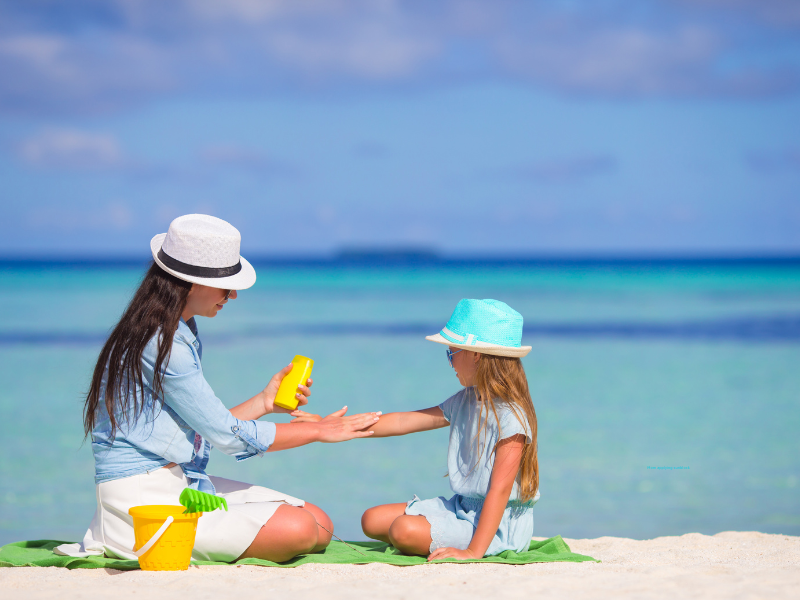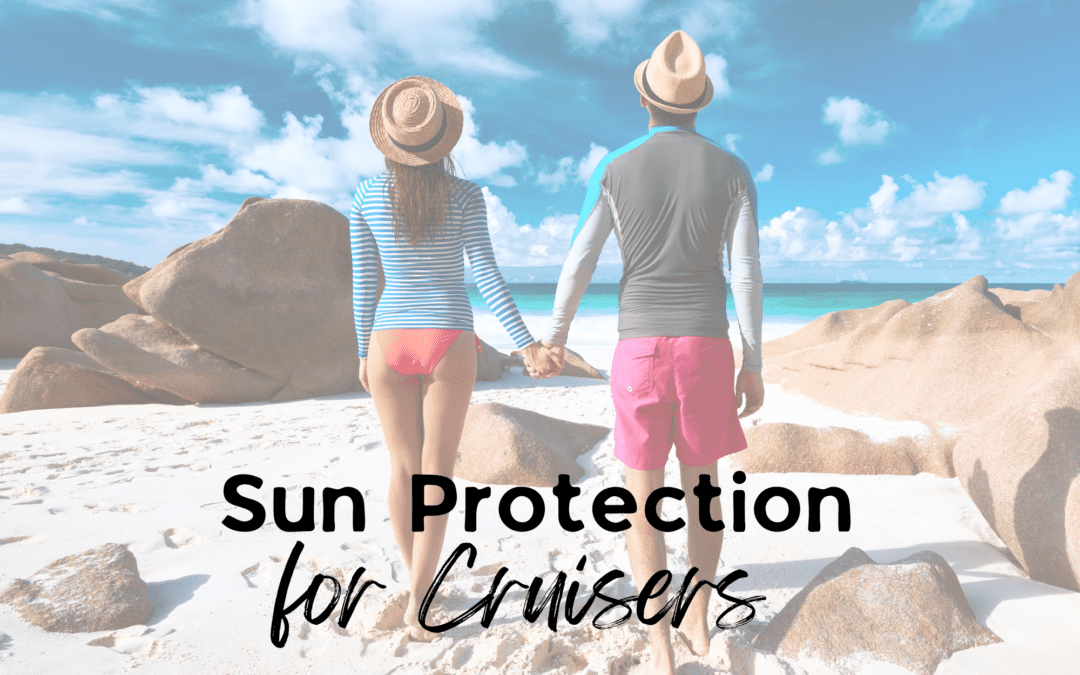Are you planning a cruise and worried about sunburn? We once thought sun protection was just a minor detail, but a painful experience on a Caribbean vacation taught us otherwise. Our carefree attitude towards the sun left us red, raw, and regretful.
That’s when we noticed something interesting: many local guides and boat operators wore long-sleeved shirts. These weren’t your typical cotton button-downs. They were lightweight, comfortable, and designed for sun protection. Intrigued, we started to explore the world of sun-protective clothing.
Remember: The sun’s rays can be intense even on sea days walking around the ship or port days doing activities. Learn more about sea days and port days in our guides:
How to make the most of sea days on a Carnival Cruise
All you need to know about port days for new cruisers
One sea day, Mike thought it would be a good idea to go without his shirt while we sat on the pool deck watching the ice carving contest. By the end of the day, he was burnt, and red, like a lobster. That’s when we realized the importance of sun protection, even on seemingly mild days.
Sun Shirts: Our Must-Have for Sun Protection
We quickly realized that these long-sleeved shirts were more than just a fashion statement. They were a practical solution to a problem we’d been ignoring. These sun shirts, as we’d later learn, were designed to block harmful UV rays, providing superior protection compared to traditional sunscreen.
Intrigued, we began researching sun protection clothing. We discovered a world of high-tech fabrics, innovative designs, and a growing awareness of the importance of shielding our skin from the sun’s damaging rays. Sun shirts offer several advantages, including:
- Superior UV protection: Many sun shirts have a UPF rating of 50 or higher, meaning they block 98% of harmful UV rays.
- Comfort and breathability: Modern sun shirts are often made from lightweight, moisture-wicking fabrics that keep you cool and comfortable in hot weather.
- Versatility: Sun shirts can be worn as a standalone garment or layered with other clothing.
- Durability: Quality sun shirts are built to last, so they can be a worthwhile investment.
Gallivanting Souls is reader-supported. When you buy through links on our site, we may earn an affiliate commission. As an Amazon Associate, I earn from qualifying purchases. Learn more.
Sun Protection Options for Cruisers
Sunscreen is a crucial component of sun protection. Choose a broad-spectrum sunscreen with a high SPF (Sun Protection Factor) that protects against both UVA and UVB rays. If you’ll be swimming or sweating, opt for a water-resistant formula. Remember to reapply sunscreen every two hours, especially after swimming or sweating.
Accessories can also provide valuable protection. A wide-brimmed hat shields your face, neck, and ears from the sun, while sunglasses with UV protection protect your eyes. An umbrella can offer additional shade, especially during peak sun hours.
Clothing is another effective way to protect yourself from the sun. Look for sun-protective clothing with a high UPF (Ultraviolet Protection Factor) rating. Consider wearing long sleeves and pants, especially during peak sun hours. Choose lightweight, breathable fabrics that block harmful UV rays.
Here’s the revised paragraph with the link:
By combining these options, you can effectively protect your skin from the sun’s harmful rays and enjoy your cruise without worrying about sunburn. For additional safety and preparedness, consider creating a DIY emergency kit for your cruise. [https://gallivantingsouls.com/cruise-emergency-first-aid-kit/]
Sunscreen: Your Essential Shield
Sunscreen is a crucial part of your sun protection arsenal. Here’s a brief overview of different types and how to use them effectively:
Types of Sunscreen
- Chemical: Absorbs UV rays and converts them into heat.
- Physical (mineral): Reflects UV rays away from the skin.
- Hybrid: Combines both chemical and physical filters for broader protection.
Choosing the Right Sunscreen
- Broad-spectrum: Protects against both UVA and UVB rays.
- High SPF: Choose an SPF of 30 or higher for daily use.
- Water-resistant: Opt for water-resistant sunscreen if you’ll be swimming or sweating.
How to Apply Sunscreen
- Generous application: Use about a quarter-size amount for your face and neck, and a full ounce for your body.
- Even coverage: Apply sunscreen evenly to all exposed areas, including your ears, neck, and the backs of your hands.
- Reapplication: Reapply every two hours, or more frequently if swimming or sweating.
- Sensitive skin: If you have sensitive skin, consider using a fragrance-free sunscreen.
Remember: Sunscreen is most effective when applied before going outdoors. It’s also important to seek shade during peak sun hours (usually between 10 AM and 4 PM).
Sun Protection Accessories
Hats: A Stylish Shield
Hats are a stylish and practical way to protect your face, neck, and scalp from the sun’s harmful rays. Here are some popular options:
- Wide-brimmed hats: Offer the most comprehensive protection, shielding your face, neck, and ears.
- Baseball caps: A classic choice for casual wear, but provide less coverage than wide-brimmed hats.
- Bucket hats: Offer full coverage for your head and neck, making them ideal for outdoor activities.
- Visors: Provide protection for your face and eyes, but leave your head and neck exposed.
When choosing a hat, look for one with a UPF rating of 50 or higher for maximum sun protection.
For some of my favorite cruise accessories and recommendations check out my Benable list: [https://benable.com/GallivantingSouls/amazon-cruise-essentials]
Sunglasses: Protecting Your Eyes
Sunglasses are more than just a fashion accessory; they are essential for protecting your eyes from harmful UV rays. Exposure to excessive UV radiation can lead to cataracts, macular degeneration, and other eye problems.
When choosing sunglasses, look for the following features:
- UV protection: Ensure your sunglasses block both UVA and UVB rays.
- Polarized lenses: Reduce glare from reflective surfaces, improving vision and reducing eye strain.
- Sunglasses with a high quality frame: A well-fitting frame will ensure your sunglasses stay in place and provide optimal protection.
Remember to wear sunglasses whenever you’re outdoors, even on cloudy days. UV rays can penetrate clouds and still damage your eyes.
The Benefits of Sun Shirts
Sun shirts offer many advantages that make them an essential piece of sun protection gear.
- Superior Sun Protection: Unlike traditional sunscreen, which needs constant reapplication, sunshirts provide consistent protection against both UVA and UVB rays. Many sun shirts boast UPF ratings of 50+ or higher, blocking out a significant percentage of the sun’s harmful radiation.
- Skin Health: By shielding your skin from the sun’s damaging rays, sunshirts help prevent sunburn, premature aging, and skin cancer.
- Comfort: Modern sun shirts are designed with comfort in mind. They’re often made from lightweight, breathable fabrics that wick away moisture, keeping you cool and dry.
- Versatility: Sun shirts come in various styles, from rash guards for water activities to long-sleeved options for hiking or sightseeing.
- Convenience: Simply slip on a sun shirt and you’re protected. No more messy sunscreen application or reapplication.
Most skin cancers are caused by too much exposure to ultraviolet (UV) light. Protection from UV rays is important all year.
Different Types of Sun Shirts
Sun shirts come in a variety of styles to suit different activities and preferences.
By Sleeve Length
- Long-sleeve: Offers maximum sun protection for arms and torso. Ideal for hiking, fishing, and outdoor adventures.
- Short-sleeve: Provides sun protection for the upper body but leaves arms exposed. Suitable for less intense sun conditions or activities like boating.
- Sleeveless: Primarily protects the torso, often paired with sunscreen for arm protection. Best for water activities like swimming or paddleboarding.
By Style
- Rash guards: Designed for water sports, offering a tight fit and quick-drying fabric.
- T-shirts: Casual and comfortable, available in various styles and colors.
- Hoodies: Provides additional head and neck protection, ideal for cooler weather or extended sun exposure.
- Performance shirts: Built for active lifestyles, with features like moisture-wicking and odor control.
By Fabric
- Polyester: Lightweight, quick-drying, and offers excellent UPF protection.
- Nylon: Durable and strong, often used for performance-oriented sun shirts.
- Cotton: Comfortable but offers minimal sun protection unless treated with UV-blocking agents.

Sun Shirts for Different Activities
- Paddle Boarding: Rash guards or lightweight, long-sleeved sun shirts
- Surfing: Rash guards, long-sleeved rash guards, or quick-drying sun shirts
- Hiking: Long-sleeved sun shirts with moisture-wicking properties
Fabric and Style: Key Considerations
Choose the fabric and style that best suits your needs and preferences:
- Fabric: Polyester, nylon, cotton (with UV-blocking), performance fabrics
- Style: Classic T-shirt, performance fit, button-down, rash guard, hoodies
Video: What you need to know about sun safety
Who Needs Sun Protection Shirts?
Sun protection shirts are a versatile and comfortable way to enjoy your cruise vacation without worrying about the sun. Everyone can benefit from sun protection shirts. While they are particularly beneficial for:
- Fair-skinned individuals: People with lighter skin tones are more susceptible to sunburn and UV damage.
- People with sun sensitivity: Some individuals have medical conditions or take medications that make them more sensitive to the sun.
- Anyone who spends extended time outdoors: Cruises often involve spending hours on deck soaking up the sun, exploring ashore, or participating in water activities.
- Water enthusiasts: Whether you’re kayaking, snorkeling, or simply splashing around in the pool, sun protection shirts can help to prevent sunburn, even when wet.
Clothing is the most effective form of sun protection

Sun Protection Shirts for Women
Choose a style that suits you:
- Sleeve length: Long or short
- Zipper closure: Half-zip, quarter-zip, or full-zip
- Ruching: For added style and comfort
Find your perfect look:
- Designs: Classic, prints, patterns, tropical themes
- Price points: Budget-friendly to high-performance
- Matching sets: Shorts or bikini bottoms
Popular brands that can be found online include:
Sun Protection Shirts for Men
Choose a style that suits you:
- Classic styles: Crewneck tees, long-sleeve button-ups
Find your perfect fit:
- Performance fabrics: Lightweight, breathable, quick-drying
- Sun protection options: Long or short sleeves, UPF 50+
Sun Protection Shirts for Little Ones
Keep your kids cool, comfortable, and protected:
- Soft and breathable fabrics: Ensure a comfortable fit for delicate skin.
- Full coverage: Choose shirts with long sleeves, high necklines, and even built-in sun hats for maximum protection.
- Easy on and off: Look for features like snaps or zippers for quick and easy diaper changes.
- SPF ratings: Opt for shirts with a UPF rating of 50+ for the highest level of sun protection.
- Fun designs: Choose from a variety of colors, patterns, and character prints to keep your kids excited.
Complete the look:
- Matching swimsuits: Coordinate sun protection shirts with swim diapers or bottoms for a complete sun-safe outfit.

Sun Protection Shirts: Your Everyday Essensial
Sun protection shirts are a versatile piece of clothing that can be worn in various situations where sun protection is important. While they’re perfect for a day at the beach, their benefits extend far beyond the shore. Here’s a look at how sun protection shirts can be your️ shield against harmful UV rays in a variety of settings:
- Hiking and Outdoor Activities: Whether you’re exploring a new trail, going for a nature walk, or spending a day at the campsite, sun protection shirts offer a comfortable layer of defense against harmful UV rays.
- Amusement Parks and Outdoor Events: Long days spent waiting in lines or enjoying outdoor festivals can expose you to a significant amount of sun. Sun protection shirts provide coverage while you wait for that next rollercoaster ride or cheer on your favorite performer.
- Playing Sports: From tennis matches to beach volleyball tournaments, sun protection shirts can help athletes stay cool and protected from the sun while they enjoy their favorite sport.
- Everyday Errands: Even quick errands on a sunny day can lead to sunburn. Sun protection shirts offer a casual and comfortable way to protect yourself from incidental sun exposure.

What Are Sun Protection Shirts?
Sun protection shirts are specially designed garments that offer superior protection against harmful UV rays. They are made from fabrics that block or absorb UV radiation, reducing the risk of sunburn and long-term skin damage. These sun protection shirts include Rash Guards and Swim Shirts.
Key Features of Sun Protection Shirts
UV Protection
Sun protection shirts are designed to block or absorb harmful UV rays, offering a high level of defense against sunburn and skin damage.
Lightweight Fabric
These shirts are made from lightweight materials that ensure comfort and ease of movement, perfect for active cruisers.
Quick-Drying Material
The quick-drying properties of sun protection shirts make them ideal for water activities and humid conditions, keeping you dry and comfortable.
Breathable Design
With breathable fabrics, these shirts allow for better air circulation, helping to regulate body temperature and prevent overheating.
What Our Cruisers Say
“As an avid cruiser, I can’t imagine going on a trip without my sun protection shirt. It keeps me safe from harmful UV rays while allowing me to enjoy my adventures worry-free.” – Sarah L.
Conclusion
Sunburns are a drag, and the last thing you want is for them to ruin your perfect cruise getaway. Sun protection clothing is a game-changer for savvy cruisers. It provides excellent sun protection, keeps you comfortable, and comes in a variety of styles.
Remember to combine sun-protective clothing with other essential sun protection measures:
- Sunscreen: Apply a broad-spectrum sunscreen with a high SPF.
- Accessories: Wear a wide-brimmed hat and sunglasses for added protection.
By incorporating sun-protective clothing into your cruise wardrobe, you can enjoy your vacation without worrying about sunburn. So ditch the sunscreen worries and pack some sun protection clothing for your next cruise. Your skin (and your vacation memories) will thank you!
Discover More Travel Tips
Ready to enhance your cruising experience? Visit the Gallivanting Souls website for more tips and products designed to make your travels safe and enjoyable. Click below to explore our resources!
Sun Protection FAQs
Here are some answers to frequently asked questions about sun-protective clothing:
Q: Is a Rash Guard the same as SPF?
A: A rash guard is a garment with a UPF rating that blocks UV rays, whereas SPF refers to the Sun Protection Factor of sunscreen, which measures its ability to block UVB rays. Think of rash guards as built-in sun protection for your clothing.
Q: What is the Purpose of a Rash Guard?
A: Rash guards offer sun protection and can also help prevent chafing from rubbing against a surfboard or other water gear.
Q: Can You Wear a Rash Guard as a Swim Top?
A: Absolutely! Rash guards are designed to be worn in the water and are typically made from quick-drying, chlorine-resistant materials.
Q: Do Swim Shirts Prevent Sunburn?
A: Yes, swim shirts with a UPF rating can help prevent sunburn. Look for a UPF rating of 50 for the best protection.
Q: Do you put Sunscreen Under a Swim Shirt?
A: While a swim shirt offers protection, it’s still recommended to wear sunscreen on exposed areas like your face, neck, and hands. Reapply sunscreen every two hours, or more often if you’re sweating or swimming.
Q: What is a Swim Shirt? What is a Rash Guard?
A: Both offer sun protection, but rash guards are typically tighter fitting and designed for activities like surfing that involve friction. Swimshirts can be looser and offer more variety in styles.
Q: Rash Guard vs Dri-Fit
A: Dri-Fit is a fabric technology from Nike that wicks away moisture but may not have a UPF rating. A swim shirt specifically designed for sun protection will have a UPF rating.
Q: Do you wear anything under a swimshirt? (Ladies)
A: You can wear a sports bra or bikini top under a swim shirt, depending on the level of coverage and support you prefer.
Q: How to choose Sun Protective Clothing
A: Consider the activities you’ll be doing. Rash guards are good for water sports, while swim shirts offer a looser fit for lounging or light activity. Choose a UPF rating of 50 for the best protection. Look for quick-drying, comfortable fabrics.
Q: What is UPF?
A: UPF stands for Ultraviolet Protection Factor. It’s similar to SPF but for clothing and measures how effectively the fabric shields you from UV rays. A UPF rating of 50 blocks 98% of UV rays.
Q: Does UPF Clothing Work?
A: Yes, UPF clothing that is rated UPF 50 can significantly reduce your risk of sunburn.
Q: What Fabric is best for UPF?
A: Tightly woven fabrics like nylon or polyester are best for UPF protection. Look for clothing with a high thread count.
Q: Does UPF Clothing work in Water?
A: Yes, most UPF clothing is designed to hold its protective qualities when wet.
Q: What Color is best for UPF?
A: Darker colors generally offer more protection than lighter colors. However, a light-colored shirt with a high UPF rating will still provide excellent sun protection.
Q: Best Sun Protection for Beach/Cruises
A: A combination of sun-protective clothing, sunscreen, hat, and sunglasses is the best approach for sun safety on your beach vacation or cruise.
Q: What are Swim Shirts?
A: Swim shirts are loose-fitting garments made from quick-drying, moisture-wicking fabrics that often have a UPF rating for sun protection.
Q: What are Rash Guards?
A: Rash guards are tighter-fitting garments designed for water activities. They offer UPF protection, and abrasion resistance, and can help prevent chafing.
Q: Do Rash Guards protect from UVA Rays?
A: Yes, rash guards with a UPF rating of 50 block UVA and UVB rays.
Q: Does UPF Clothing only come in Shirts?
A: Sun-protective clothing comes in a variety of styles, including pants, hats, hats, and even board shorts.
Q: Where to Buy UPF Clothing?
A: UPF clothing can be found at sporting goods stores, outdoor outfitters, and online retailers.
Q: Should I wear long-sleeve or Short-sleeve sun protection shirts?
A: Long sleeves offer more sun protection, but short sleeves can be a good option for cooler climates or if you’ll be spending most of your time in the water.
Q: Do T-shirts work for Sun Protection?
A: Regular cotton t-shirts offer minimal sun protection. They have a low UPF rating, and when wet, offer even less protection. For effective sun protection, look for clothing specifically designed with sun protection in mind, like rash guards or swim shirts with a UPF rating of 50.
Q: What’s the difference between sunscreen and sunblock?
A: While the terms are often used interchangeably, there is a slight difference. Sunscreen absorbs UV rays and converts them into heat, while sunblock physically reflects UV rays away from the skin.
Q: Are there any natural alternatives to sunscreen?
A: Yes, there are some natural sunscreen options available. However, it’s important to note that natural sunscreens may not provide the same level of protection as chemical or mineral sunscreens. Always check the SPF and ingredients to ensure it meets your needs.
Q: What is reef-safe sunscreen?
A: Reef-safe sunscreen is a type of sunscreen that is less harmful to coral reefs and other marine life. It typically contains mineral-based ingredients like zinc oxide or titanium dioxide, rather than chemical filters that can damage coral reefs.
Q: Why is reef-safe sunscreen important?
A: Traditional sunscreens often contain chemicals like oxybenzone and octinoxate that have been linked to coral bleaching and other harmful effects on marine ecosystems. Using reef-safe sunscreen helps to protect these delicate ecosystems.
Q: How can I choose a reef-safe sunscreen?
A: When selecting a reef-safe sunscreen, look for products that are:
- Mineral-based: Contains zinc oxide or titanium dioxide.
- Oxybenzone-free: Avoid products containing oxybenzone.
- Octinoxate-free: Avoid products containing octinoxate.
Q: What are some essential sun protection accessories besides clothing?
A: In addition to sun-protective clothing, consider these accessories:
- Hats: Wide-brimmed hats offer the most comprehensive protection for your face, neck, and ears.
- Sunglasses: Choose sunglasses with UV protection to shield your eyes from harmful rays.
- Umbrellas: An umbrella can provide additional shade, especially during peak sun hours.
Remember to combine these accessories with sunscreen and sun-protective clothing for optimal protection.

